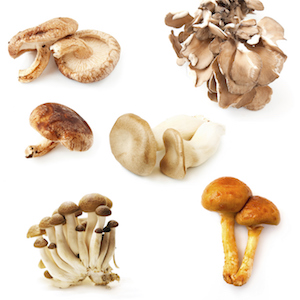 Most of us think of mushrooms as food. If you grew up in the sixties, you might even think of “shrooms” as a way to get high. But few people recognize what powerful medicines mushrooms (also known as fungi) can be. Yet, mushrooms have been used for healing for thousands of years, most notably in traditional Chinese medicine (TCM). Today, scientific research has confirmed that more than 270 species of fungi have therapeutic value.
Most of us think of mushrooms as food. If you grew up in the sixties, you might even think of “shrooms” as a way to get high. But few people recognize what powerful medicines mushrooms (also known as fungi) can be. Yet, mushrooms have been used for healing for thousands of years, most notably in traditional Chinese medicine (TCM). Today, scientific research has confirmed that more than 270 species of fungi have therapeutic value.
Fungi are not plants. They are more closely related to animals for several reasons. First, their cell walls contain chitin, which is similar to insects, instead of the cellulose found in plants. Second, they digest other organisms and the byproducts of other organisms rather than creating energy through photosynthesis. They store energy as glycogen, like people and animals, instead of starch like in plants.
Fungi are nature’s recyclers and make life on this planet possible. They actually help plants absorb minerals, which is why they are important in the soil. They help plants grow better and can help to rebuild forests and help plants resist pathogens. They also break down toxins and have tremendous potential to clean up chemicals in the environment like: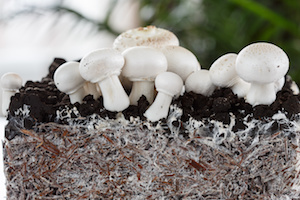
- Heavy metals (arsenic, cadmium, lead, and mercury)
- Petrochemicals (oil, gas, tar, etc.)
- Pesticides
- Radioactive materials
- Industrial wastes
Fungi grow from spores that generate threads of cells called hyphae. You’ve seen these when bread or cheese gets moldy. These join together to create a mat called mycelium, the white threads under the mushrooms shown in the picture on the right. Under the right conditions mycelium send up the fruiting bodies we call mushrooms, which produce the spores.
Mushrooms and Health
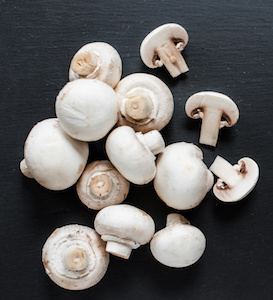 Mushrooms have many healing properties, especially for the immune system. Various species can both stimulate the immune system to help the body fight infections and cancer, as well as modulate the immune system to reduce excess immune activity in autoimmune disorders. Many medicinal mushrooms have adaptogenic, antioxidant and anti-inflammatory effects, making them great for promoting overall health and reducing the effects of stress.
Mushrooms have many healing properties, especially for the immune system. Various species can both stimulate the immune system to help the body fight infections and cancer, as well as modulate the immune system to reduce excess immune activity in autoimmune disorders. Many medicinal mushrooms have adaptogenic, antioxidant and anti-inflammatory effects, making them great for promoting overall health and reducing the effects of stress.
Mushrooms can also be hepatoprotective, which means they protect the liver (and other organs) from damage from environmental toxins. They can lower blood pressure and cholesterol to benefit the heart and circulation, too. Some even have calming effects on the nerves.
We have about 5,000 species of fungi living in our bodies, which are normally benign and possibly even beneficial. Under certain conditions, such as lowered immune function, pH imbalances or a lack of friendly bacteria, they can overgrow and produce fungal infections like Candida albicans. However, using medicinal mushrooms will not contribute to fungal infections in the body. That’s like saying probiotics contribute to bacterial infections. It just isn’t true.
Medicinal Compounds in Mushrooms
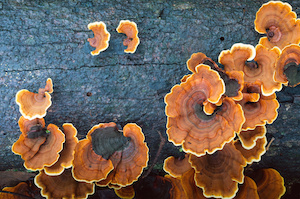 Medicinal mushrooms contain a number of bioactive compounds, including triterpenoids, proteins, and complex polysaccharides such as beta-glucans. In dried form, tonic fungi are composed of about 80% polysaccharides, 10%-15% protein, 2%-3% oil, and 2%-6% minerals, and other compounds. Medicinal mushrooms can be important sources of B vitamins such as riboflavin, folate, thiamine, pantothenic acid, and niacin. They also provide trace minerals such as selenium, copper, and iron.
Medicinal mushrooms contain a number of bioactive compounds, including triterpenoids, proteins, and complex polysaccharides such as beta-glucans. In dried form, tonic fungi are composed of about 80% polysaccharides, 10%-15% protein, 2%-3% oil, and 2%-6% minerals, and other compounds. Medicinal mushrooms can be important sources of B vitamins such as riboflavin, folate, thiamine, pantothenic acid, and niacin. They also provide trace minerals such as selenium, copper, and iron.
The cell walls of tonic fungi contain polysaccharides called 1,3 beta-glucans, which have been studied for their role in enhancing immunity, improving insulin resistance, and lowering cholesterol. These polysaccharides have powerful immune-modulating action, unlike the 1,3 beta-glucans found in barley, oats and other cereals. The level of beta-glucan content varies in each type of fungi. For instance, it is about 9% in the almond Portobelo, 14.5% in maitake, and 41% in reishi. A level of about 9% is needed for a fungus extract to have immune-modulating activity.
Beta-glucans are not directly antiviral or cytotoxic to cancer cells, but they are effective in stimulating natural killer cell (NK cell) activity. In fact, tonic mushroom preparations can increase NK cell activity by as much as 400% and can stimulate the production of tumor necrosis factor alpha (TNF-a) and other substances used by NK cells to initiate programmed cell death and destroy cancerous and viral-infected cells. The resulting localized cytokine concentration draws macrophages, cytotoxic T cells, and more NK cells to the area, thereby mobilizing the immune system.
Unfortunately, the beta-glucans in fungi are so tightly bound to the chitin in the cell wall that they pass through the body largely unabsorbed unless the chemicals are extracted and broken off the cell wall by prolonged steam or hot water. So, simply grinding up the mushrooms and ingesting them does not make these compounds bioavailable. They are also not alcohol soluble, so you cannot get them from tinctures. They must be extracted by boiling or steaming the fungi, which breaks down the chitin into its N-acetylglucosamine building blocks and frees the 1,3 beta-glucans from the cell wall, converting them to small, bioavailable fragments.
In addition to beta-glucans, the polysaccharide fraction of tonic mushrooms includes resistant starch, essential sugars, and other constituents. Resistant starch, which makes up about 15% dry weight of many fungi, is an excellent prebiotic for promoting beneficial bacteria in the large intestine.
Essential sugars, or glyconutrients, make up about 10% dry weight of many fungi. These sugars have a stimulating effect on white blood cells and the formation of antibodies. They help the immune system recognize pathogens and cancer cells and communicate these discoveries to the rest of the immune system so it can perform its job more effectively.
Meet the Medicinal Mushrooms
There are many species of medicinal fungi, but they tend to have some of the following health-promoting properties. Many aid the immune system in fighting infection. They can be immune-stimulating, antibacterial, antiviral and antifungal. They can also help the body recognize and destroy tumors. Many are also immune balancing, which means they can help to calm down immune reactions in autoimmune disorders.
Medicinal mushrooms can also be antioxidant, cholesterol-reducing and adaptogenic, meaning they can reduce stress and help the body adapt to harsh environmental conditions. They can also be tonics for the liver and kidneys. Some can also aid reproductive function.
Here is some additional information on specific immune-enhancing mushrooms.
Cordyceps (Cordyceps sinensis, C. militaris)
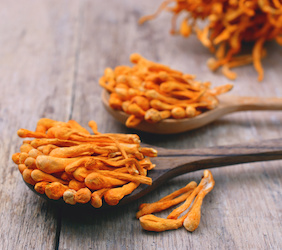 Cordyceps made international headlines in 1993 when female Chinese runners decimated world records in a major competition. Their coach attributed this remarkable athletic performance to the use of caterpillar fungus or cordyceps.
Cordyceps made international headlines in 1993 when female Chinese runners decimated world records in a major competition. Their coach attributed this remarkable athletic performance to the use of caterpillar fungus or cordyceps.
Cordyceps is a fungus that grows on the larvae of a caterpillar. While the caterpillar is hibernating underground, the fungus invades the organism and consumes the bug. The result is a caterpillar shaped mushroom. In the spring, it puts up a stem-like mushroom, which gives the herb its Chinese name—dong chong xia cao. Literally translated this means, “winter bug, summer grass.”
The cordyceps shown on the left is raised on a medium like rice. There's a picture below and right which shows the actual wildcrafted cordyceps. I took this picture when I was in a Chinese pharmacy in 2006.
Cordyceps is an energy tonic in Chinese medicine and has been used for about 1,500 years. It enhances both the yin and the yang energy in the body and it supports the Chinese kidney (water) and lung (metal) energy. In Western terms, it possesses adaptogenic, antioxidant, sedative and immune balancing characteristics. It also has a hepatoprotective effect, enhances kidney and lymphatic function and helps balance blood sugar levels.
The Chinese kidney system includes some aspects of adrenal function because it relates to basic energy and stamina. There is also an aspect of reproductive function in the Chinese kidney energy system. Cordyceps helps in all these areas. It increases energy, improves stamina and can overcome sexual dysfunction. Researchers have shown that cordyceps increases ATP production, which enhances cellular energy. This helps explain its traditional use in enhancing strength and endurance.
Other studies suggest that cordyceps has potent antioxidant and anti-inflammatory properties. It measures 12,000 on the ORAC scale and can be helpful for inflammation associated with asthma and rheumatoid arthritis. It also has a protective effect on the liver and kidneys and is a tonic for the heart, cardiovascular system, and lungs. It can help to improve blood flow, normalize cholesterol levels and may help reduce blood pressure.
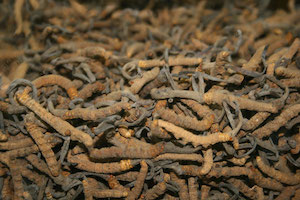 Cordyceps stimulated testosterone production in laboratory animals and increased a type of estrogen essential to fertility in another study. This correlates with its Chinese reputation as a tonic for sexual weakness and reduced libido.
Cordyceps stimulated testosterone production in laboratory animals and increased a type of estrogen essential to fertility in another study. This correlates with its Chinese reputation as a tonic for sexual weakness and reduced libido.
The lung or metal energy in the Chinese system relates to the immune function in Western medicine and cordyceps definitely aids the immune system. It enhances the ability of the body to prevent and fight infection and is very helpful for people who have weak lungs and are constantly getting sick.
It is also helpful in asthma and COPD (chronic obstructive pulmonary disease). Improvements in symptoms such as shortness of breath, cough, appetite, and energy have been reported.
Cordyceps may also enhance the immune function in both cancer and autoimmune disorders. One study showed cordyceps helpful for animals with systemic lupus. It can strengthen a person undergoing chemotherapy and reduces blood vessel growth to the tumors.
Cordyceps is a good remedy for the elderly. Doses of just 3 grams per day (about 6 capsules) have resulted in improvements in energy, libido, memory, and tolerance to cold, and reductions in dizziness, cold intolerance, tinnitus and frequent nighttime urination. A typical dose for enhancing respiratory or immune function would be 2-3 capsules three times daily. There are no known side-effects or drug interactions.
Reishi (Ganoderma lucidum)
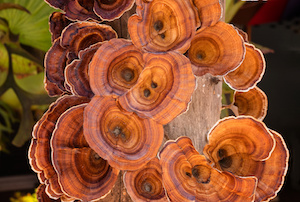 Japanese researchers began studying Reishi, also known as Ganoderma, in the mid-1980s. Their published findings caught the attention of Western researchers, who began to study the fungus, which has been used for thousands of years in traditional Chinese medicine (TCM). Reishi has consistently impressed the biomedical community as a potential source for hypertension, diabetes, hepatitis, cancer, and AIDS drugs. The picture to the left is reishi being grown on wood, while the picture below and right is a picture I took of dried reishi in a Chinese herb shop in Las Vegas.
Japanese researchers began studying Reishi, also known as Ganoderma, in the mid-1980s. Their published findings caught the attention of Western researchers, who began to study the fungus, which has been used for thousands of years in traditional Chinese medicine (TCM). Reishi has consistently impressed the biomedical community as a potential source for hypertension, diabetes, hepatitis, cancer, and AIDS drugs. The picture to the left is reishi being grown on wood, while the picture below and right is a picture I took of dried reishi in a Chinese herb shop in Las Vegas.
Clinical studies show that Reishi has a wide range of actions. For starters, it boosts the immune function (via natural killer cells, macrophages and interferon) to fight both viral and bacterial infections. It also balances or modulates the immune system in auto-immune disorders. Because of this, Reishi is widely used for conditions of immune deficiency such as cancer, AIDS and chronic fatigue syndrome, as well as autoimmune conditions such as lupus, rheumatoid arthritis, Crohn’s disease, and Ankylosing spondylitis. It may also be helpful in treating allergies, bronchitis, HIV, and inflammation.
Reishi’s anticancer activity is unique in that its triterpenes and polysaccharides limit tumor growth by blocking the abnormal reproductive cycles of cancer cells. Some of its compounds induce apoptosis (programmed cell death) in cancer cells, while sparing healthy tissue. Other compounds in Reishi inhibit metastatic processes and decrease the expression of genes involved in cancer cell survival, proliferation, invasion, and metastasis.
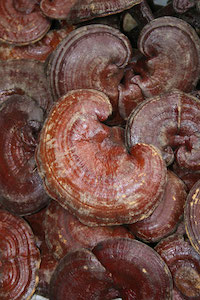 In vitro studies using synovial fluid from patients with rheumatoid arthritis found that Reishi’s polysaccharides have an inhibitory effect on the proliferation of synovial fibroblasts, possibly via the nuclear factor-kappa B transcription pathway. Polysaccharides isolated from Reishi have also proven effective in vitro against herpes simplex virus types 1 and 2. Reishi isolates have also been tested against other viral strains, including influenza A, and demonstrated effectiveness against their replication.
In vitro studies using synovial fluid from patients with rheumatoid arthritis found that Reishi’s polysaccharides have an inhibitory effect on the proliferation of synovial fibroblasts, possibly via the nuclear factor-kappa B transcription pathway. Polysaccharides isolated from Reishi have also proven effective in vitro against herpes simplex virus types 1 and 2. Reishi isolates have also been tested against other viral strains, including influenza A, and demonstrated effectiveness against their replication.
Reishi also offers cardiovascular support, lowering blood pressure and serum cholesterol, reducing blood pressure, and protecting the heart. It has been used in the treatment of heart deficiency, angina pectoris, heart palpitations, and arrhythmia.
Reishi is hepatoprotective, protecting the liver against radiation and damage by toxins. It has an ORAC value of 4,000. Reishi also has neuroprotective properties. It has a significant ability to stimulate brain neurons.
Reishi can help to balance blood sugar and prevent the development of new fat cells in obese individuals. In a study involving diabetic rats, Reishi enhanced carbohydrate metabolism and promoted insulin secretion. In a clinical trial of patients with type II diabetes, 1800 mg. of Reishi is given 3 times daily reduced glucose levels. In other clinical studies, the glucans in Reishi inhibited hypoglycemia.
Maitake (Grifola frondosa)
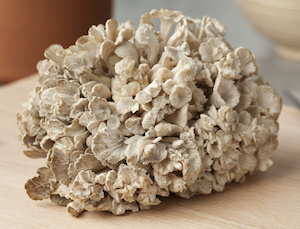 Maitake is a soft polypore mushroom typically found growing at the base of aging oaks, elms, and maple trees. It has been used in traditional Japanese medicine for centuries. After arousing the curiosity of Western medical researchers, extracts of maitake were studied for their effects on the immune system and various cancers. The research suggests that maitake induces apoptosis of cancer cells and has anti-angiogenic properties, restricting the proliferation of blood vessels that feed tumors. Other studies show that maitake can shorten the course of cancer chemotherapy, prevent chemotherapy side effects, and prevent the destruction of T cells by HIV.
Maitake is a soft polypore mushroom typically found growing at the base of aging oaks, elms, and maple trees. It has been used in traditional Japanese medicine for centuries. After arousing the curiosity of Western medical researchers, extracts of maitake were studied for their effects on the immune system and various cancers. The research suggests that maitake induces apoptosis of cancer cells and has anti-angiogenic properties, restricting the proliferation of blood vessels that feed tumors. Other studies show that maitake can shorten the course of cancer chemotherapy, prevent chemotherapy side effects, and prevent the destruction of T cells by HIV.
The fruiting body of maitake is rich in complex polysaccharides, especially the beta-D-glucans. The mycelium contains low molecular weight sugars and exopolysaccharides, known to activate immune responses and enhance the ability of immune cells to kill and consume lung and breast cancer cells.
Besides enhancing immunity, maitake may also help control both high blood pressure and blood sugar levels. The a-glucosidase inhibitors it contains are believed to be responsible for these benefits.
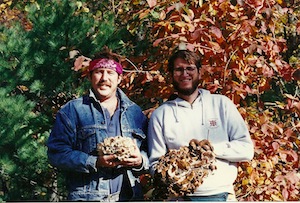 Years ago, when I had a beard for a short period of time (as you can see), I went wildcrafting for maitake in the Pennsylvania woods with my friends Kalman (left of me) and Dawn. It was a lot of fun looking for these vary large mushrooms. I got lucky (or else was good at following my intuition, because I found a bigger one that Kalman, who had far more experience.
Years ago, when I had a beard for a short period of time (as you can see), I went wildcrafting for maitake in the Pennsylvania woods with my friends Kalman (left of me) and Dawn. It was a lot of fun looking for these vary large mushrooms. I got lucky (or else was good at following my intuition, because I found a bigger one that Kalman, who had far more experience.
We went back to the house and Dawn sliced them, dipped them in flour and sauteed them in butter. They were absolutely delicious. We dried some and I took them home and added them to a soup. They were very much like chicken in the soup. Kalman said that they grow prolifically before a harsh winter, which suggests that they can help fortify the body for winter.
Shiitake (Lentinula edodes)
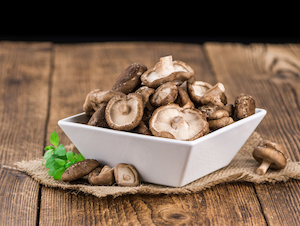 Famous for its rich texture and meaty flavor, shiitake may be the most researched fungi in terms of potential health benefits. Studies show that shiitake is rich in vitamins, minerals, antioxidants, and phytonutrients, but it also contains powerful compounds that discourage inflammation and “bad” bacteria, inhibit tumor growth, and destroy harmful viruses and fungi. Studies also show that shiitakes also have antiviral and anticancer effects.
Famous for its rich texture and meaty flavor, shiitake may be the most researched fungi in terms of potential health benefits. Studies show that shiitake is rich in vitamins, minerals, antioxidants, and phytonutrients, but it also contains powerful compounds that discourage inflammation and “bad” bacteria, inhibit tumor growth, and destroy harmful viruses and fungi. Studies also show that shiitakes also have antiviral and anticancer effects.
Specifically, shitake produces a large amount of vitamin D when exposed to sunlight, can be used as a natural vitamin D supplement. It has been used as medicine in China for at least 500 years, for upper respiratory diseases, poor blood circulation, liver trouble, exhaustion and weakness, and low life energy or qi. It contains lentian, a protein-rich polysaccharide that stimulates macrophages which boost other parts of the immune system. It also contains antiviral compounds. For example, a water-soluble lignin-rich fraction has been found to have powerful antiviral activity
Shitake grows on dead or dying hardwood trees and has been cultivated for food and medicine on small scale in China and Japan for over 1,000 years. 1982 research made large-scale commercial cultivation possible, and shiitake subsequently entered the U.S. market, where it can often be found in supermarkets and eaten as an immune and health-enhancing food.
Turkey Tail (Coriolus versicolor, Polyporus versicolor)
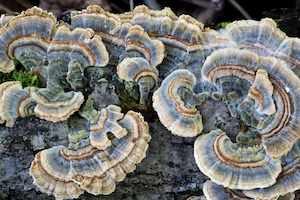 Turkey tail grows on dead hardwood trees and is one of the most abundant mushrooms found in deciduous forests. Grows on dead trees (hardwoods) and is the most common mushroom in deciduous forests. Enzymes secreted from its mycelium are some of the most potent toxin-destroyers found in nature, which means it could be very helpful for cleaning up environmental pollution.
Turkey tail grows on dead hardwood trees and is one of the most abundant mushrooms found in deciduous forests. Grows on dead trees (hardwoods) and is the most common mushroom in deciduous forests. Enzymes secreted from its mycelium are some of the most potent toxin-destroyers found in nature, which means it could be very helpful for cleaning up environmental pollution.
There are some good studies showing it contains various compounds having immune-boosting activity. Studies suggest various compounds in it inhibit the growth of various types cancer cells, initiate apoptosis and stimulate immune responses such as natural killer cells. In fact, an extract, known as PSK or krestin, is an approved anticancer drug in Asia.
Chaga (Inonotus obliquus)
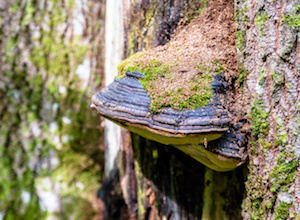 Chaga typically grows on birch trees in Northern Europe, Asia, and Canada and has been used by Eastern Europeans, Eurasians, Scandinavians, and Native Americans. The dried mushroom is used as a tinder to make fires, which gives rise to its other common names clinker polypore and cinder conk.
Chaga typically grows on birch trees in Northern Europe, Asia, and Canada and has been used by Eastern Europeans, Eurasians, Scandinavians, and Native Americans. The dried mushroom is used as a tinder to make fires, which gives rise to its other common names clinker polypore and cinder conk.
Chaga was traditionally used for tuberculosis, ulcers, heart, lung and liver problems. In 1955 an extract from it was approved as an anticancer drug (betungin) in Russia. There has been some pharmacological research done on it in the West starting in the 1980s, but there needs to be more research.
It has immune-modulating qualities and stimulates macrophage and natural killer cells, which are part of the innate immune system. It also appears to contain antiviral and antioxidant compounds.
Agaricus (Agaricus bitorquis, A. rodmannii)
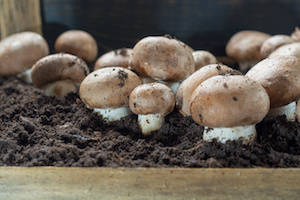 There are many Agaricus species, which includes the white mushrooms most people are familiar with as well as crimini and portobello mushrooms. Not all species in the Agaricus genus are edible, however. The edible Agaricus are great mushrooms for helping to utilize waste from feedlots. They grow well in manure, especially when it is mixed with straw or sawdust.
There are many Agaricus species, which includes the white mushrooms most people are familiar with as well as crimini and portobello mushrooms. Not all species in the Agaricus genus are edible, however. The edible Agaricus are great mushrooms for helping to utilize waste from feedlots. They grow well in manure, especially when it is mixed with straw or sawdust.
In traditional Chinese medicine button mushrooms were used to regulate body energy and remove phlegm from the body. They were often combined with reishi. They contain beta-glucans and other compounds that are antibacterial and antiviral. So, they can help to boost immune responses.
Poria or Hoelen (Wolfiporia cocos)
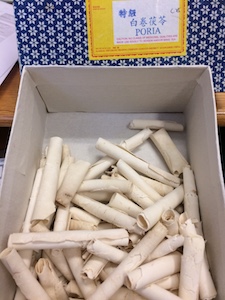 Our final fungus is a while mushroom that grows on wood, particularly on pine trees. It has a long history of use in Chinese medicine. However, the part used isn’t the mushroom, it’s the sclerotium, which is a compact mass of hardened fungal mycelium that stores food reserves. The poria sclerotium develops underground and looks somewhat like a coconut.
Our final fungus is a while mushroom that grows on wood, particularly on pine trees. It has a long history of use in Chinese medicine. However, the part used isn’t the mushroom, it’s the sclerotium, which is a compact mass of hardened fungal mycelium that stores food reserves. The poria sclerotium develops underground and looks somewhat like a coconut.
In TCM, poria it is considered a diuretic, relaxing nervine and nutritive. It has antibacterial activity and is used as a fortifying agent in TCM formulas. I took the picture on the left of some poria slices I got from the Chinese herb shop in Chinatown in Las Vegas.
There are many beneficial mushrooms besides those mentioned in this article. Other varieties that may benefit human health include lion’s mane, morels, and oyster mushrooms. Mushrooms are extremely safe remedies, but don’t harvest them from the wild unless you know what you are doing, as there are many toxic fungi as well. Remember the old saying, “There are old mushroom hunters, and bold mushroom hunters, but there are no old, bold mushroom hunters.” So, get your medicinal mushrooms from quality suppliers who can guarantee you’ve got the right fungi.
References
Mycelium Running: How Mushrooms Can Help Save the World by Paul Stamets
The Fungal Pharmacy by Robert Rodgers, RH(AHG)
Oriental Materia Medica: A Concise Guide by Hong-Yen Hsu
Medicinal Mushrooms by Christopher Hobbs
Steven's Articles
-

-
The Sensible Use of Caffeinated Herbs
Kola nuts, guarana, and yerba mate and other herbs…
-

-
The Health Benefits and Problems with Coffee
This popular caffeinated beverage can be beneficial…
October
-

-
Understanding Caffeine & Cellular Adaptation
Preserving the power of caffeine's buzz and the…
September
-

-
Horseradish
A pungent spice for aiding protein metabolism…
-

-
Banaba or Crepe Myrtle
A beautiful tree from Southeast Asia whose leaves…
August
-

-
Monkeyflowers
Flower essences to help see ourselves more clearly…
-

-
Mariposa Lilies
Strengthening the bond between mother and child…
-

-
The Noble Bay Leaf
A common kitchen herb for aiding digestion and…
-

-
Epimedium: Horny Goat Weed
A circulatory stimulant and kidney yang tonic…
July
-

-
The Medicinal and Nutritional Benefits of Apricots
A nutritious fruit and valuable medicinal seed for coughs
-

-
Dogwoods
Asian dogwood is used to stop excessive discharge,…
June
-

-
Neem: The Village Pharmacy
A popular Ayurvedic remedy for dental and immune…
-

-
Spilanthes: The Toothache Plant
A traditional remedy for teeth and gums, as well…
-

-
Forsythia
An anti-inflammatory, fever-reducing, and infection fighting herb
May
-

-
Buckwheat (Kashi)
A delicious, high protein, gluten-free, gut-healthy food

